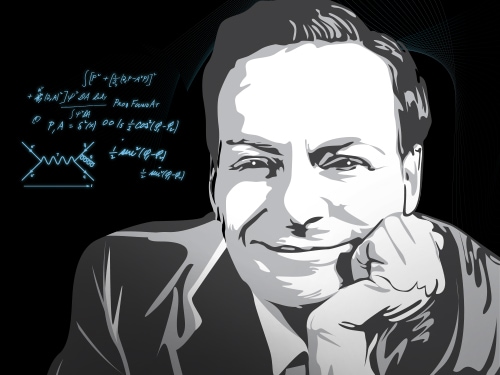

Richard Feynman lived from 1918 to 1988 and his contributions to science were extraordinary. Beginning with his work on the atomic bomb in the early part of his career, to his breakthroughs in quantum mechanics which earned him a Nobel Prize in 1965, his key role in investigating the Challenger Space Shuttle disaster in 1986, to his career as a much-loved professor at Caltech in the USA.
Feynman has also been credited with pioneering the field of quantum computing, and introducing the concept of nanotechnology. He was ranked as one of the ten greatest physicists of all time in a 1999 poll by the UK journal, Physics World.
Yet, Feynman led an unusual life and it would be impossible to truly understand his approach to science without understanding the person he was. He put joy and humour into learning, and was famous for his practical jokes and passion for playing the bongos and cracking safes.
In the first section of the exhibition, discover Feynman’s life through personal letters and family photographs, his bongos, paintings, a recreation of the quirky van he used to drive, and a number of his own paintings, which are being exhibited outside of the United States for the first time.
72 unique artefacts provide a fascinating insight into Feynman’s world and highlight the many paths he took in his life.

Richard Feynman’s Letters to Arline
While working on his PhD, Feynman proposed to his high school sweetheart, Arline Greenbaum. Arline had been diagnosed with tuberculosis and tragically was not expected to live much longer. On 29 June 1942, just two weeks after receiving his PhD, Feynman and Arline were married.
While he was stationed in a secret facility in Los Alamos, Arline moved to the Presbyterian Sanatorium, a nearby hospital, where he visited her every weekend. When they were not together, they would write touching love letters to each other, several of which are on show in the exhibition.

Lessons in Art and Science
Feynman was a semi-secret amateur artist. Starting at the age of 44, and after a series of amicable arguments with his artist-friend Jirayr Zorthian, the two agreed that on alternate Sundays they would teach each other about art and science. From that point on, Feynman continued to draw and paint for the rest of his life, signing off each painting with the pseudonym “Ofey”.
He explains his motivation behind his interest in drawing: “I wanted very much to learn to draw, for a reason that I kept to myself: I wanted to convey an emotion I have about the beauty of the world. It’s difficult to describe because it’s an emotion.”
Exhibited in this gallery are some of Feynman’s sketches and paintings.

Feynman’s Bongos
Apart from his scientific discoveries, Feynman’s passion for the bongos was perhaps one of the things he was most known for.
He played the bongos throughout his life, especially with his friend, Ralph Leighton. They would have weekly gatherings where they would improvise and develop rhythms. This led to them playing music for theatrical plays and even for a ballet recital.

Challenger Disaster
In 1986, Feynman received an eloquent and thoughtful letter from President Ronald Reagan, 40th President of the United States, thanking him for his historical work related to the Space Shuttle Challenger disaster.
Feynman demonstrated live on television with a simple experiment what caused the Challenger to explode and unveiled management problems in NASA at that time.


